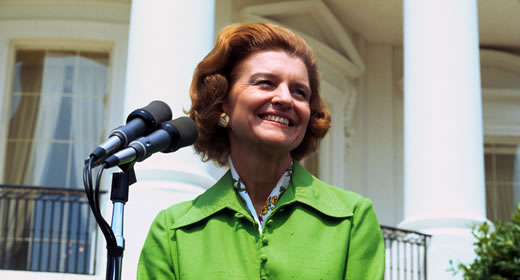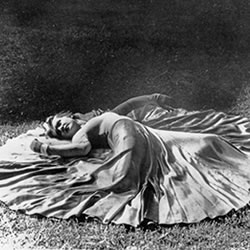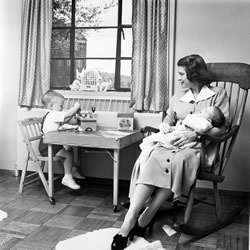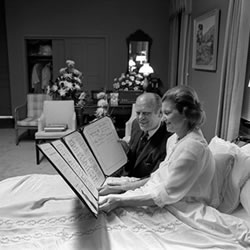
Being ladylike does not require silence
There are photos and movies of Betty Ford in her family home from the 1960s. They show a caring homemaker and mother, busy looking after her husband and four young children in their suburban Virginia home. In these images, she looks every inch the typical midcentury middle-class housewife.
But typical is one thing this woman was not. From her childhood until her death in 2011, Betty Ford balanced responsibility with her own expressive and lively spirit—a spirit that occasionally stretched the confines of decorum.
Betty Ford, born Elizabeth Ann Bloomer in 1918, grew up expressing herself. Her fondness for modern dance, which she studied for several years after high school, showed her flair for bold, boundary-pushing communication. She also grew up with a mother who was a role model of an independent woman: Betty Ford's mother had supported herself and her three children by working as a real estate agent for several years after the death of her first husband.
 |
|
Betty Ford, a Calla Travis Dance School instructor, poses during a performance of "Fantasy" in Grand Rapids, MI in 1942. |
Betty Ford too, was employed. She began giving dance lessons as a teenager and continued, off and on, until she got married. She also worked as a model and later as a department store fashion buyer.
With this background, it is no surprise that when she was taken from her 1960s suburban-housewife life and thrust into the public eye in the White House, she had opinions. She cared about the status of women's rights and opportunities in the United States. And when she found herself in a position to be influential, she was happy to speak up.
From stovetop to bully pulpit
In 1973, Gerald R. Ford (HLLD '74, AB '35) was serving in his 24th year as the representative from Michigan's 5th congressional district. When Vice President Spiro T. Agnew resigned, President Richard M. Nixon appointed Ford to the vice presidency. At the ceremony announcing Gerald Ford as vice president, Nixon is said to have congratulated Betty Ford. "Congratulations? Or condolences?" she quipped. However reluctant and surprised Betty Ford was to be thrust into the public eye, she soon began to expand the traditional role of the vice president's spouse. The second lady generally doesn't receive attention from the news media; Betty Ford was different.
 |
|
Betty Ford holds second son Jack while eldest son Michael plays in their apartment in Alexandria, VA in 1952. |
She attracted attention when she volunteered to represent the administration at the funeral of Martin Luther King Jr.'s mother. She expressed controversial opinions in magazine interviews, saying that if she learned one of her children used marijuana, "I'd be understanding. I would object and try to reason with them rather than try to use force." She told Good Housekeeping that she supported Roe v. Wade: "I'm glad abortion has been taken out of the back rooms and put into the hospitals where it belongs."
And she spoke out in favor of women's economic rights. In a June 1974 speech at the Women's Center for Life-Long Learning at Utah State University, Ford said that a third of women were sole household wage earners. She decried the wage discrepancy between men and women, a problem she said was for "our whole society, not just the individual woman."
Betty Ford's stage was about to be elevated. In July 1974, Nixon resigned the presidency rather than be impeached in the Watergate scandal. Gerald Ford became the president and Betty Ford became the First Lady.
Women's health and women's rights
 |
|
President Gerald Ford and First Lady Betty Ford read a get well card, signed by all 100 members of the United States Senate, at Bethesda Naval Hospital in Maryland following the First Lady's breast cancer surgery in 1974. |
In 1974 First Lady Betty Ford was diagnosed with breast cancer and had a mastectomy. Because of public sensitivity about women and their anatomy, breast cancer was a taboo disease and a diagnosis of breast cancer was often a death sentence. The Fords were forthcoming with the American public about her illness. Their candor is credited with raising the visibility of this disease and with increasing the numbers of women having mammograms and saving the lives of untold individuals.
When Betty Ford recovered, she turned her attention to the passage of the Equal Rights Amendment (ERA). In 1974 five more states were needed to ratify the amendment for it to become part of the Constitution and Betty put her policy influence to bear on those remaining states.
She began a campaign of writing and calling legislators in nine states to urge passage of the ERA. In the end, Betty Ford's efforts on behalf of the ERA were not enough to carry the day. But she continued to champion women's rights.
In an October 1975 speech, she said: "Many barriers continue to the paths of most women, even on the most basic issue of equal pay for equal work…The first important steps have been to undo the laws that hem women in and lock them out of the mainstream of opportunities…My own support of the Equal Rights Amendment has shown what happens when a definition of proper behavior collides with the right of an individual to personal opinions. I do not believe that being First Lady should prevent me from expressing my views. I spoke out on this important issue, because of my deep personal convictions. Why should my husband's job or yours prevent us from being ourselves? Being ladylike does not require silence."
See also: U-M and Ford School pay tribute to the life and legacy of Betty Ford
Photos of Mrs. Ford: Gerald R. Ford Presidential Library. Story by Bob Brustman.
Below is a formatted version of this article from State & Hill, the magazine of the Ford School. View the entire Fall 2012 State & Hill here.
